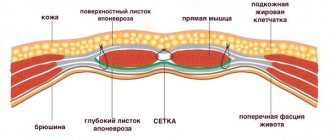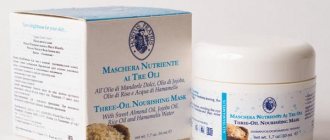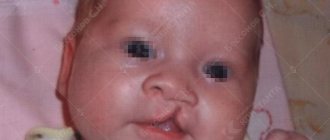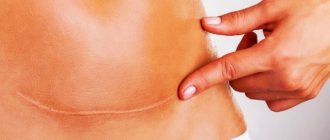Why do children develop an umbilical ring defect?
Medical systematization by type of origin umbilical hernias are defined as congenital
or
purchased
.
- A congenital hernia in a child is visually identified by a doctor immediately after birth - in the navel area there is a spherical (or cone-shaped) protrusion with a wide base, which passes into the umbilical cord.
- An acquired hernia can occur up to the age of three. Its visual identification is similar to that of a congenital hernia.
What is the cause of congenital umbilical hernia
A few days after the baby is born, the umbilical cord falls off. The umbilical ring consists of two parts. The lower part, where the umbilical arteries and urinary duct pass, contract well and form dense scar tissue. The umbilical vein runs in the upper part. Its walls are thin, do not have a muscular membrane, and subsequently contract poorly, which, with weak peritoneal fascia and an open umbilical vein, contributes to the formation of an umbilical hernia.
The contents of an umbilical hernia are usually intestinal loops. With light pressure, the hernial protrusion is freely retracted inward. With a very wide umbilical ring and a large hernia, intestinal peristalsis is sometimes visible outwardly, that is, contraction of the intestinal muscles and the movement of food through it, which is very frightening for many parents, but this does not cause inconvenience to the baby.
An important reason contributing to the occurrence of this pathology is the frequent increase in intra-abdominal pressure. It can be caused, for example, by frequent crying of a child, gas, constipation. The hole at the top of the umbilical ring may be wide and not cause distress to the baby. But in the case of a small defect with hard edges, the child may be worried. When a baby screams or cries, a hernial protrusion appears, which usually alarms parents.
Parents often associate the child’s increased anxiety with a strangulated umbilical hernia, but such developments of umbilical hernia pathologies in infants are extremely rare (in these cases, the hernial contents are fixed by adhesions to the inner wall of the skin of the anterior abdominal wall). As a rule, an umbilical hernia in children is always reducible. A strangulated umbilical hernia can be found more often in adult practice.
The main cause of umbilical hernias is a hereditary predisposition to weakness of the muscles of the anterior abdominal wall due to connective tissue dysplasia. This means that if the father or mother of the child themselves had this pathology in childhood, then the probability that their child will have a hernia is about 70%.
Misconception about umbilical hernia in newborns
There is a persistent misconception among parents that an umbilical hernia in a child often occurs due to an error by the obstetrician, who cut the umbilical cord incorrectly. Today, this superstition has no objective conditions because in obstetric practice the technique of applying an umbilical bracket , which leaves no chance for error even for a young obstetrician.
The direct cause of an umbilical hernia in newborns is an anatomical feature determined by the physiological weakness of the connective tissue in the navel area.
How to “earn” an acquired umbilical hernia
A preliminary diagnosis of “umbilical hernia” can be made during examination by the pediatrician observing the child. In the future, the doctor should refer the baby for a consultation with a surgeon to receive additional recommendations for monitoring and treating this condition.
The main causes of acquired hernia in a child:
- Due to the frequent and prolonged crying of the child, when the abdominal muscles are constantly tense, the internal organs are under pressure.
- Constipation and flatulence provoke periodic short-term but intense increases in intra-abdominal pressure and, as a result, the umbilical ring does not contract as effectively as it should, and, consequently, intestinal loops or the omentum can prolapse beyond the abdominal wall, forming a hernia.
- Early walking can also cause a hernia. During this period, the abdominal muscles receive a new unusual load and may not be strong enough.
Types of hernioplasty
There are two types of this operation: traditional hernioplasty and plastic surgery using a mesh implant.
When performing plastic surgery with mesh installation, the surgeon uses two methods: installs a mesh implant in the subcutaneous space above the navel, if it is not possible to repair the hernia, or places the implant under the navel ring. This type of operation can be performed either under general anesthesia or using local anesthesia; the risk of relapse when installing an implant is reduced to 1%, and the recovery period does not exceed 1 month.
Reviews about the operation
It's been 4 years since I had hernia surgery. Everything was fine until I got scared and screamed very sharply - from the tension the hernia appeared again. We did it the traditional way, but now I will insist on installing a patch. The doctor was very wise, he told and showed everything, assured that everything would be wonderful. Victoria, Ekaterinburg
He underwent surgery in the capital’s clinic in Ukraine at Family Longevity. Surprisingly, there was no pain either during or after the operation.
They operated on me under local anesthesia for about half an hour - I dozed for half of the operation, and spent the second half talking with the surgeon about life. Again, there was no pain.
The doctor did not allow me to drive, but I personally did not notice a single reason not to drive - nothing hurt. Andrey, Kyiv
My husband had such an operation at the center on Skhodnya... They didn’t keep me in the hospital for long - they did everything in the morning and released me in the evening. They forced me to wear a bandage around the clock for the first month, and for the second month I could only wear it during the day. The doctor advised me to put on a mesh, but it is much more expensive.
We consulted with other doctors and were told that only old or very fat people need mesh; young people have absolutely healthy muscles and mesh can only harm them (the whole body, since it is a foreign body). Healed without a mesh.
So far I still carry no more than 5 kg at a time, but I feel much better. Elena, Moscow
A wonderful doctor works at hospital number 119 in Novogorsk! He performed the operation on us and told us everything about it. He talked about how the procedure goes, whether it is necessary to install a mesh and, in general, why it is needed, he talked about the consequences, and warned what and how to do after the operation.
He forced me to do a bunch of tests, and for that I am grateful to him... Before the hernia appeared, I was very careless about my health... And after meeting the doctor, I realized how wrong I was! The operation went well, under local anesthesia. There wasn't much pain, maybe it was a little unpleasant.
Elena, St. Petersburg
My operation was done very quickly, but it was done under general anesthesia. As soon as I recovered from the anesthesia, I immediately ran off to walk around the hospital, I think it will be the same for everyone else. The doctor prescribed it after 5 days, allowed everything except weight lifting and physical education - I had to forget about running... Tanya, Saransk
A day after the operation, I could barely stand on my feet... They did it the traditional way. It was, I admit, painful to get up for the first time. They immediately forced me to put on a bandage and not take it off for 2 months. They discharged me after 10 days and strictly forbade me from lifting anything heavy, including a child. Veronica, Moscow
And my hernia was removed 2 months ago. I was kept in the hospital for a total of 2 weeks (they did tests for 1 week, then they had surgery, and the rest of the time I was recovering). On the second day after the operation, I could walk comfortably on my own, it was not painful. The doctor allowed me to lift no more than 5 kg, and I need to do this for another year. Lyuba, Moscow
Umbilical hernia
My daughter is 1-8 years old, also has an umbilical hernia, they say if it doesn’t go away by three, it will be sutured. We ride with our belly on a fitball, I would advise you to go to Chudakov with your child.
We are 1.11. We also have an umbilical hernia. The navel came out only when the child, about 8 months old, stood on his legs against the support, and before that nothing came out. The hernia doesn’t bother the child at all, the daughter just touches her navel from time to time and that’s all. The doctors are also not saying anything useful yet, they suggest waiting. We do a massage course every 3 months.
Very grateful to those who responded. Especially in private. Only I see that no matter how much patience I accumulate, it will end in surgery, because... The weak point is the navel in everyone's family.
So why don’t they come up with an easy cosmetic surgery for dolls while they don’t understand anything about wasting time at the hospital at school age when there are plenty of other problems.
Yes, a hernia is not the worst thing that can happen, but if it is, why not resolve the current issue now, and not accumulate it for years. A hernia every day, like a nasty scab, will always annoyingly irritate the eye, no matter how you calm yourself down.
You will massage it, strengthen it, but everything will be in vain (you're a filthy pessimist). I reassure myself that they will do cosmetics, and then, due to the unformed body, it will come out again and there will be more problems (hasn’t medicine come up with anything about this yet).
So why don’t they come up with an easy cosmetic surgery for dolls while they don’t understand anything about wasting time at the hospital at school age when there are plenty of other problems.
How not to be mistaken that your child has an umbilical hernia
The following signs are sufficient to accurately identify the disease:
- a protrusion in the navel area that decreases in size or disappears when lying down.
- abdominal pain that occurs with exercise and coughing.
- umbilical ring expansion
Diagnostic methods
Diagnostic methods for children are not numerous and are limited to the following list:
- examination by a pediatric surgeon;
- hernial protrusion;
Diseases with similar symptoms
There are not many diseases with similar symptoms; their list can be limited to the following:
- Hernia of the white line of the abdomen;
- Endometriosis of the navel;
- Oncological diseases and metastases of tumors of the stomach and duodenum (mainly in adults);
Methods for diagnosing hernia
Diagnosis of a hernia is carried out during examination of the patient. In this case, the doctor uses the methods of palpation (palpation), percussion (tapping) and auscultation (listening to the natural sounds of the body).
To obtain a more complete picture, instrumental studies are performed:
Radiography
Radiography of a hernia allows one to obtain additional information about the presence of adhesions, parietal strangulation of the hernia and partial intestinal obstruction.
More information about the diagnostic method
Ultrasound examinations
Ultrasound makes it possible to clarify the location of the hernia, the shape and size of the hernial orifice, assess the condition of the surrounding tissues (this allows you to choose the most effective technique for reducing the hernia), and determine the contents of the cavity of the hernial sac.
More information about the diagnostic method
Computed tomography (CT)
Computed tomography for hernia is used if ultrasound data is insufficient.
More information about the diagnostic method
Sign up for diagnostics To accurately diagnose the disease, make an appointment with specialists from the Family Doctor network.
Prevention of acquired umbilical hernia
Prevention of the occurrence of an umbilical hernia is, first of all, the prevention of excessive straining of the child and bloating, which is usually caused by increased gas formation and constipation.
To prevent excessive intestinal bloating in a child and the development of constipation, the most favorable option for young children is breastfeeding, but the mother must follow a diet. We can advise mothers to temporarily exclude the following foods from their diet: whole milk, white cabbage, legumes, nuts, sweets, smoked meats, sausages. It is preferable to consume fermented milk products, bran, whole grain cereals, fresh vegetables and fruits. During breastfeeding, prunes and dried apricots (no more than 3-5 berries per day) are useful for preventing constipation.
If the baby is bottle-fed, in order to avoid constipation, bloating, colic, or an allergic reaction, the formula should be selected by a pediatrician. The doctor observing your baby may recommend medications: SAB-SIMPLEX, ESPUMIZAN, PLANTEX, BABY-CALME, etc.
To prevent constipation, which can occur in a baby due to improperly selected artificial nutrition, due to errors in the diet of a nursing mother, as well as in dysbacteriosis and other diseases of the gastrointestinal tract, in which excessive straining occurs, pediatricians recommend taking DUPHALAC among medications. , as well as the introduction of GLYCERIN SUPPLIES and microenemas - MICROLAX. Your pediatrician will tell you the dosage and specifics of administering these medications, since the prescription of drug therapy is purely individual and can only be done by the doctor monitoring your baby’s development.
Children with lactose intolerance (lactase deficiency) quite often have umbilical hernias. Lactase deficiency occurs in children who were born prematurely or at term, but remain functionally immature. In this condition, breast milk is partially or completely not digested, resulting in fermentation in the intestines and bloating. In addition, one of the forms of lactase deficiency may be a tendency to constipation. The most effective means of prevention for such children is a rational selection of feeding; during breastfeeding, additional administration of the lactase enzyme is often recommended.
At an early age, many children suffer from intestinal dysbiosis, that is, a violation of the intestinal microflora, which can occur against the background of lactase deficiency and other conditions. At the same time, constipation, as well as bloating, which accompanies dysbacteriosis, quite often provoke the occurrence of an umbilical hernia in babies. Treatment in this case should be aimed primarily at eliminating the symptoms of the underlying disease.
How umbilical hernia in children is treated in Russia
Traditional treatment
Traditional methods of treating umbilical hernia in children have taken root well in the historical consciousness of the Russian population. From generation to generation, grandmothers and aunts of children with umbilical hernia syndrome tell their mothers encouraging stories about “miraculous” deliverance from hernias with the help of village healers. Among these inventive and resourceful healing methods, three methods stand out:
- Conspiracies with manual-tactile actions in the navel area;
- Applying a piece of an alloy of non-ferrous metals to the navel, in common parlance: “copper coins”;
- The use of a mixture of dried herbs in the form of tea leaves, the authorship of which is pretentiously attributed to hermits from the Christian-church pantheon.
Common sense ignores the empirical content of these “methods,” finding no reason to discuss the impossible. It is known that such social phenomena are the subject of study by specialists in legal law and social psychiatry.
Doctors explain the phenomenon of the existence of these wild superstitions in modern educated society by the ability of the child’s body to independently get rid of the symptoms of an umbilical hernia (so-called self-healing). In classical medicine, this fact is a scientifically based guarantee of parents’ hope for self-healing from a hernia, but for healers it is a reason to replace the true cause with their home-grown techniques.
A good recommendation for responsible parents is to definitely visit a pediatrician if you suspect the first signs of an acquired umbilical hernia. If your baby was diagnosed with an umbilical hernia in the maternity hospital, then in a few weeks make an appointment with a pediatric surgeon at your municipal medical institution (the referral is given by the pediatrician at the first visit).
So that you don’t miss anything from the specialist’s valuable recommendations, take your baby’s dad with you. Men cope better with new information and his additions to your memory will be useful. Strictly follow the doctor’s recommendations, remember that your diligence, together with parental love, is a reliable guarantee of the expected treatment result.
Today in our country, the system of medical patronage for children's health allows us to effectively treat many diseases in the early stages. And it is the pleasant duty of parents to take full advantage of this civilizational advantage over past generations.
Conservative treatment – or treatment of umbilical hernia without surgery
Up to 5 years of age, an umbilical hernia is not operated on, since it is possible to close the defect on its own. Many doctors believe that hernias that had the potential to heal themselves disappear in children under the age of 3, maximum 4 years; some authors talk about the possibility of closing PG before 6 years of age. But both experts agree that it is imperative to operate on umbilical hernias in children 6 years of age and older.
Complications
- If there is a hernia, it can be strangulated at any time. The organ located in the hernial sac becomes inflamed, blood circulation is disrupted, tissue necrosis and peritonitis develop. This complication is caused by lifting heavy objects, impaired bowel function, and physical activity (even small ones). Infringement can occur if the patient sneezes, coughs, or laughs. As a result, sharp, unbearable pain appears, the temperature of the hernial sac rises, and it becomes hard. Often accompanying symptoms are fever, vomiting, and headache. In this case, the patient needs urgent surgery.
- Inflammation of the internal organs located in the hernial sac. In this case, the person feels pain, the protrusion turns red, swells, and the overall body temperature rises. The patient's condition becomes worse.
- Intestinal obstruction. Occurs when feces clog the part of the intestine that is located in the hernial sac. Symptoms are similar to strangulation - nausea, constipation, vomiting, severe pain.
Umbilical hernia - surgery
Specialists perform operations to remove umbilical hernia in St. Petersburg. Affordable prices and professional surgeons.
Surgical treatment of pediatric umbilical hernia at the Laser Medicine Center
or why you shouldn’t be afraid to go to a pediatric surgeon
If the time allotted by nature to your baby’s health for self-healing is coming to an end, if all your conscientious efforts to help your child cope with this harmless pathology have not yielded results, then you should not hesitate and gather your courage and make a decision on surgical treatment of the hernia.
Please note that the uniqueness of a child for parents does not apply to his illness for a doctor. If a pediatric surgeon has several dozen operations to repair an umbilical hernia, then his professional experience is a sufficient guarantee of the success of the operation. When you are dealing with a doctor who has performed hundreds of similar operations, the child’s parents have an objective reason to be completely confident in the successful surgical treatment of their child.
Dear Parents.
You can get qualified help regarding the treatment of an umbilical hernia, as well as hernial protrusions of other origins, in the pediatric surgery department of the multidisciplinary clinic “Laser Medicine Center”.
We widely use modern effective treatment methods to achieve positive results. The department is equipped to the most modern standards, so your stay in the hospital will be as comfortable as possible.
Surgical techniques
Open hernia repair
Surgical treatment of an umbilical hernia using the open method is carried out using classical techniques.
With tension hernioplasty, the umbilical ring is sutured in the extreme places of the aponeurosis. Sutures are applied in a vertical or transverse position.
With tension-free hernioplasty, the defect is removed through an incision near the navel, after which a mesh endoprosthesis is sutured in place of the hernial orifice and securely connected with surgical threads.
Laparoscopic surgery
This is a gentle technique that provides the patient with an easy and quick recovery. No large incisions are made on the skin - the instrument is inserted into the abdominal cavity through incisions up to 5 mm long. During laparoscopy of an umbilical hernia, the image of the operation progress is displayed on the monitor, and the surgeon has complete control over his actions. Using special tools, the mesh is fixed. Due to the absence of damage to the abdominal wall, the load on the mesh implant is distributed evenly.
Radio wave technology
It involves manipulation using an electrode (radiosurgery knife). It delivers radio waves of the required frequency to remove the hernia. The technique allows you to close the hernial orifice with minimal trauma. Purulent complications and relapses are excluded.
Laser technology
The hernial orifice closes under the influence of a directed laser beam. Bleeding and injury to local tissues are excluded.









